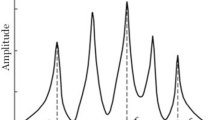Abstract
In this paper the possibility of using transient tests, generated by the Portable Pressure Wave Maker (PPWM) device, as a powerful tool in the management of pipe systems, is demonstrated. Specifically, tests carried out in different experimental set-ups at the Water Engineering Laboratory of the University of Perugia, Italy show that small amplitude sharp pressure waves produced by the PPWM allow to locate and evaluate the entity of anomalies, such as leaks, illegal branches, partial blockages, and negligently partially closed in-line valves. To improve the precision of localization of anomalies, arrival times of pressure waves are detected by means of wavelet analysis. Simple relations based on the water hammer theory are proposed to evaluate the entity of the anomalies.
Similar content being viewed by others
References
Al-Shidhani I, Beck SBM, Staszewsky WJ (2003) Leak monitoring in pipeline networks using wavelet analysis. Key Eng Mater 245–246:51–58
Berni A, Brunone B, Ferrante M (2005) A 2-d approach for energy dissipation evaluation in pressurised transient flow. In: Proc 8th int conf on ’computing and control for the water industry—CCWI 2005’, Exeter (UK), vol 1, pp 287–292
Brunone B (1999) Transient test-based technique for leak detection in outfall pipes. J Water Resour Plan Manage ASCE 125(5):302–306
Brunone B, Berni A (2010) Wall shear stress in transient turbulent pipe flow by local velocity measurement. J Hydraul Eng ASCE 31/03/2010. doi:10.1061/(ASCE)HY.1943-7900.0000234
Brunone B, Ferrante M (2001) Detecting leaks in pressurised pipes by means of transients. J Hydraul Res IAHR 39(5):539–547
Brunone B, Ferrante M, Meniconi S (2008a) Discussion of “Detection of partial blockage in single pipelines” by PK Mohapatra, MH Chaudhry, AA Kassem, and J Moloo. J Hydraul Eng ASCE 134(6):872–874
Brunone B, Ferrante M, Meniconi S (2008b) Portable pressure wave-maker for leak detection and pipe system characterization. J Am Water Works Assoc AWWA 100(4):108–116
Brunone B, Karney BW, Mecarelli M, Ferrante M (2000) Velocity profiles and unsteady pipe friction in transient flow. J Water Resour Plan Manage ASCE 126(4):236–244
Christodoulou S, Deligianni A (2010) A neurofuzzy decision framework for the management of water distribution networks. Water Resour Manage 24:139–156
Colombo AF, Karney BW (2002) Energy and costs of leaky pipes: toward comprehensive picture. J Water Resour Plan Manage ASCE 128(6):441–450
Contractor DN (1965) The reflection of waterhammer pressure waves from minor losses. J Basic Eng ASME 445–451
Daubechies I (1992) Ten lectures on wavelets. Society for Industrial and Applied Mathematics, Philadelphia
Donoho D (1995) De-noising by soft-thresholding. IEEE Trans Inf Theory 41(3):613–627
Ferrante M, Brunone B (2003) Pipe system diagnosis and leak detection by unsteady-state tests. 2. Wavelet analysis. Adv Water Resour 26(1):1274–1282
Ferrante M, Brunone B, Meniconi S (2007) Wavelets for the analysis of transient pressure signals for leak detection. J Hydraul Eng ASCE 133(11):1274–1282
Ferrante M, Brunone B, Meniconi S (2009a) Leak detection in branched pipe systems coupling wavelet analysis and a Lagrangian model. J Water Supply Res Technol AQUA 58(2):95–106
Ferrante M, Brunone B, Meniconi S (2009b) Leak-edge detection. J Hydraul Res IAHR 47(2):233–241
Jonsson L, Larson M (1992) Leak detection through hydraulic transient analysis. In: Proc int conf on ’pipeline systems’, Manchester (UK), pp 273–286
Jun H, Loganathan GV, Kim JH, Park S (2008) Identifying pipes and valves of high importance for efficient operation and maintenance of water distribution systems. Water Resour Manage 22:719–736
Kapelan Z, Savic DA, Walters GA (2003) A hybrid inverse transient model for leakage detection and roughness calibration in pipe networks. J Hydraul Res IAHR 41(3):481–492
LeChevallier M (1990) Coliform regrowth in drinking water: a review. J Am Water Works Assoc AWWA 82(11):74–86
Liggett J, Chen LC (1994) Inverse transient analysis in pipe networks. J Hydraul Eng ASCE 120(8):934–955
Mallat S, Hwang W (1992) Singularity detection and processing with wavelets. IEEE Trans Inf Theory 38:617–643
Mallat S, Zhong S (1992) Characterization of signals from multiscale edges. IEEE Trans Pattern Anal Mach Intell 14(7):710–732
Misiunas D, Vitkovsky JP, Olsson G, Simpson AR, Lambert MF (2005) Pipeline break detection using pressure transient monitoring. J Water Resour Plan Manage ASCE 131(4):316–325
Mohapatra PK, Chaudhry MH, Kassem AA, Moloo J (2006) Detection of a partial blockages in a branched piping system by the frequency response method. J Fluids Eng ASME 128:1106–1114
Nash GA, Karney BW (1999) Efficient inverse transient analysis in series pipe systems. J Hydraul Eng ASCE 125(7):761–764
Ramos H, Louriero D, Lopes A, Fernandes C, Covas D, Reis LF, Cuhna MC (2010) Evaluation of chlorine decay in drinking water systems for different flow conditions: from theory to practice. Water Resour Manage 24:815–834
Sattar AM, Chaudhry MH, Kassem AA (2008) Partial blockage detection in pipelines by frequency response method. J Hydraul Eng ASCE 134(1):76–89
Swaffield J, Boldy A (1993) Pressure surges in pipe and duct systems. Ashgate, Vermont
Wang XJ, Lambert MF, Simpson AR (2005) Detection and location of a partial blockage in a pipeline using damping of fluid transients. J Water Resour Plan Manage ASCE 131(3):244–249
Wang XJ, Lambert MF, Simpson AR, Liggett J, Vitkovsky JP (2002) Leak detection in pipelines using the damping of fluid transients. J Hydraul Eng ASCE 128(7):697–711
Willemetz JC (2000) DOP1000 application notes. Signal Processing S.A., Lausanne
Wylie E, Streeter V (1993) Fluid transients in systems. Prentice-Hall, Englewood Cliffs
Author information
Authors and Affiliations
Corresponding author
Rights and permissions
About this article
Cite this article
Meniconi, S., Brunone, B., Ferrante, M. et al. Small Amplitude Sharp Pressure Waves to Diagnose Pipe Systems. Water Resour Manage 25, 79–96 (2011). https://doi.org/10.1007/s11269-010-9688-7
Received:
Accepted:
Published:
Issue Date:
DOI: https://doi.org/10.1007/s11269-010-9688-7




